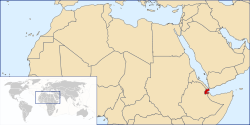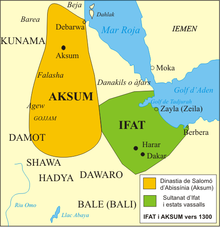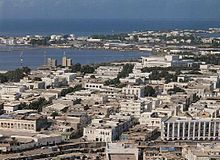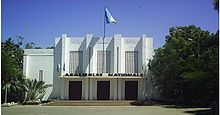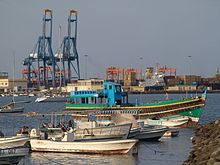
Djibouti
Background to the schools Wikipedia
This content from Wikipedia has been selected by SOS Children for suitability in schools around the world. Visit the SOS Children website at http://www.soschildren.org/
| Republic of Djibouti | ||||||
|---|---|---|---|---|---|---|
|
||||||
| Motto: "Unité, Égalité, Paix" (French) "Unity, Equality, Peace" |
||||||
| Anthem: Djibouti | ||||||
|
|
||||||
| Capital and largest city |
Djibouti 11°36′N 43°10′E |
|||||
| Official languages | ||||||
| Recognised national languages |
|
|||||
| Demonym | Djiboutian | |||||
| Government | Semi-presidential republic | |||||
| - | President | Ismail Omar Guelleh | ||||
| - | Prime Minister | Dileita Mohamed Dileita | ||||
| Legislature | National Assembly | |||||
| Independence | ||||||
| - | from France | June 27, 1977 | ||||
| Area | ||||||
| - | Total | 23,200 km2 ( 150th) 8,958 sq mi |
||||
| - | Water (%) | 0.09 (20 km² / 7.7 sq mi) | ||||
| Population | ||||||
| - | 2012 estimate | 774,389 | ||||
| - | Density | 37.2/km2 ( 168th) 96.4/sq mi |
||||
| GDP ( PPP) | 2011 estimate | |||||
| - | Total | $2.231 billion | ||||
| - | Per capita | $2,641 | ||||
| GDP (nominal) | 2011 estimate | |||||
| - | Total | $1.239 billion | ||||
| - | Per capita | $1,467 | ||||
| Gini (2009) | 40.0 medium |
|||||
| HDI (2011) | low · 165th |
|||||
| Currency | Franc ( DJF) |
|||||
| Time zone | EAT ( UTC+3) | |||||
| - | Summer ( DST) | not observed ( UTC+3) | ||||
| Drives on the | right | |||||
| Calling code | +253 | |||||
| ISO 3166 code | DJ | |||||
| Internet TLD | .dj | |||||
Djibouti ( jee-BOO-tee; Arabic: جيبوتي Jībūtī, French: Djibouti, Somali: Jabuuti, Afar: Gabuuti), officially the Republic of Djibouti, is a country located in the Horn of Africa. It is bordered by Eritrea in the north, Ethiopia in the west and south, and Somalia in the southeast. The remainder of the border is formed by the Red Sea and the Gulf of Aden at the east. Djibouti occupies a total area of just 23,200 km2 (8,958 sq mi).
In antiquity, the territory was part of the Land of Punt. The Djibouti area, along with other localities in the Horn region, was later the seat of the medieval Adal and Ifat Sultanates. In the late 19th century, the colony of French Somaliland was established following treaties signed by the ruling Somali and Afar Sultans with the French. It was subsequently renamed to the French Territory of the Afars and the Issas in 1967. A decade later, the Djiboutian people voted for independence. This officially marked the establishment of the Republic of Djibouti, named after its capital city. Djibouti joined the United Nations the same year, on September 20, 1977. In the early 1990s, tensions over government representation led to armed conflict, which ended in a power sharing agreement in 2000 between the ruling party and the opposition.
Djibouti is a multi-ethnic nation, with a population of over 770,000 inhabitants. The Somali and Afar make up the two largest ethnic groups. Both speak Afro-Asiatic languages, which serve as recognized national languages. Arabic and French constitute the country's two official languages. About 94% of residents adhere to Islam, a religion with a long-standing presence in the region.
Djibouti is strategically located near the world's busiest shipping lanes, controlling access to the Red Sea and Indian Ocean. It serves as a key refueling and transshipment centre, and is the principal maritime port for imports to and exports from neighboring Ethiopia. A burgeoning commercial hub, the nation is the site of various foreign military bases, including Camp Lemonnier. The Intergovernmental Authority on Development regional body also has its headquarters in Djibouti City.
History
Together with northern Somalia, Eritrea and the Red Sea coast of Sudan, Djibouti is considered the most likely location of the land known to the ancient Egyptians as Punt (or "Ta Netjeru", meaning "God's Land"), whose first mention dates to the 25th century BC. The Puntites were a nation of people that had close relations with Ancient Egypt during the times of Pharaoh Sahure and Queen Hatshepsut. According to the temple reliefs at Deir el-Bahari, the Land of Punt was ruled at that time by King Parahu and Queen Ati.
Through close contacts with the adjacent Arabian Peninsula for more than 1,000 years, the Somali and Afar ethnic groups in the region became among the first populations on the continent to embrace Islam.
The Ifat Sultanate was a medieval kingdom in the Horn of Africa. Founded in 1285 by the Walashma dynasty, it was centered in Zeila. Ifat established bases in Djibouti and northern Somalia, and from there expanded southward to the Ahmar Mountains. Its Sultan Umar Walashma (or his son Ali, according to another source) is recorded as having conquered the Sultanate of Shewa in 1285. Taddesse Tamrat explains Sultan Umar's military expedition as an effort to consolidate the Muslim territories in the Horn, in much the same way as Emperor Yekuno Amlak was attempting to unite the Christian territories in the highlands during the same period. These two states inevitably came into conflict over Shewa and territories further south. A lengthy war ensued, but the Muslim sultanates of the time were not strongly unified. Ifat was finally defeated by Emperor Amda Seyon I of Ethiopia in 1332, and withdrew from Shewa.
From 1862 until 1894, the land to the north of the Gulf of Tadjoura was called Obock and was ruled by Somali and Afar Sultans, local authorities with whom France signed various treaties between 1883 and 1887 to first gain a foothold in the region. In 1894, Léonce Lagarde established a permanent French administration in the city of Djibouti and named the region French Somaliland. It lasted from 1896 until 1967, when it was renamed the Territoire Français des Afars et des Issas (TFAI) (" French Territory of the Afars and the Issas").
In 1958, on the eve of neighboring Somalia's independence in 1960, a referendum was held in Djibouti to decide whether to join the Somali Republic or to remain with France. The referendum turned out in favour of a continued association with France, partly due to a combined yes vote by the sizable Afar ethnic group and resident Europeans. There was also widespread vote rigging, with the French expelling thousands of Somalis before the referendum reached the polls. The majority of those who voted no were Somalis who were strongly in favour of joining a united Somalia as had been proposed by Mahmoud Harbi, Vice President of the Government Council. Harbi was killed in a plane crash two years later.
In 1967, a second plebiscite was held to determine the fate of the territory. Initial results supported a continued but looser relationship with France. Voting was also divided along ethnic lines, with the resident Somalis generally voting for independence, with the goal of eventual union with Somalia, and the Afars largely opting to remain associated with France. However, the referendum was again marred by reports of vote rigging on the part of the French authorities. Shortly after the referendum was held, the former Côte française des Somalis (French Somaliland) was renamed to Territoire français des Afars et des Issas.
In 1977, a third referendum took place. A landslide 98.8% of the electorate supported disengagement from France, officially marking Djibouti's independence. Hassan Gouled Aptidon, a Somali politician who had campaigned for a yes vote in the referendum of 1958, eventually wound up as the nation's first president (1977–1999).
During its first year, Djibouti joined the Organisation of African Unity (now the African Union), the Arab League and United Nations. In 1986, the nascent republic was also among the founding members of the Intergovernmental Authority on Development regional development organization.
In the early 1990s, tensions over government representation led to armed conflict between Djibouti's ruling People's Rally for Progress (RPP) party and the Front for the Restoration of Unity and Democracy (FRUD) opposition group. The impasse ended in a power sharing agreement in 2000.
Government and politics
Djibouti is a semi-presidential republic, with executive power in the central government, and legislative power in both the government and parliament. The parliamentary party system is dominated by the People's Rally for Progress (RPP); the President is currently Ismail Omar Guelleh. The country's current constitution was approved in September 1992. Djibouti is a one party dominant state with the People's Rally for Progress in power. Other parties are allowed, but the main opposition, Union for National Salvation, boycotted the 2005 and 2008 elections leaving all of the legislative seats to the RPP. (See Elections in Djibouti.)
The government is seen as being dominated by the Somali Issa Dir clan, who enjoy the support of the Somali clans, especially the Isaaq (the clan of the current president's wife and many ministers & government officials) and the Gadabuursi Dir (who are the third most prominent Somali clan in Djibouti politics). The country emerged out of a decade-long civil war at the end of the 1990s, with the government and the Front for the Restoration of Unity and Democracy (FRUD) signing a peace treaty in 2000. Two FRUD members subsequently joined the cabinet, and beginning with the presidential elections of 1999, the FRUD has campaigned in support of the RPP.
Djibouti's second president, Guelleh, succeeded Hassan Gouled Aptidon in office in 1999. Despite elections of the 1990s being described as "generally fair", Guelleh was sworn in for his second and final six-year term as president after a one-man election on 8 April 2005. He took 100% of the votes in a 78.9% turnout.
The Prime Minister, who follows the Council of Ministers ( Cabinet), is appointed by the President. The Parliament (Chambre des Députés) consists of 52 members who are selected every five to nine years.
In early 2011, the Djiboutian citizenry took part in a series of protests against the long-serving government, which were associated with the larger Arab Spring demonstrations. The unrest eventually subsided by April of the year, and Djibouti's ruling People's Rally for Progress party was re-elected to office.
Military and foreign relations
The Djibouti Armed Forces have a combined troop strength of around 13,000 active personnel. It includes the Djibouti National Army, which consists of the Coastal Navy, the Djiboutian Air Force (Force Aerienne Djiboutienne, FAD), and the National Gendarmerie (GN).
The first war which involved the Djiboutian armed forces, was the Djiboutian Civil War between the Djiboutian government, supported by France, and the Front for the Restoration of Unity and Democracy (FRUD). The war lasted from 1991 to 2001, although most of the hostilities ended when the moderate factions of FRUD signed a peace treaty with the government after suffering an extensive military setback when the government forces captured most of the rebel-held territory. A radical group continued to fight the government, but signed its own peace treaty in 2001. The war ended in a government victory, and FRUD became a political party.
Djibouti has fought in clashes against Eritrea over the Ras Doumeira peninsula, which both countries claim to be under their sovereignty. The first clash occurred in 1996 after a nearly two-months stand-off. In 1999, a political crisis occurred when both sides accused each other for supporting its enemies. In 2008, the countries clashed again when Djibouti refused to return Eritrean deserters and Eritrea responded by firing at the Djiboutian forces.
As the headquarters of the IGAD regional body, Djibouti has been an active participant in the Somalian peace process, hosting the Arta conference in 2000. Following the establishment of the Federal Government of Somalia in 2012, a Djibouti delegation also attended the inauguration ceremony of Somalia's new president.
In 2001, the Djiboutian government leased the former French military base Camp Lemonnier to the United States Central Command for operations related to Combined Joint Task Force Horn of Africa (CJTF-HOA). In 2009, Central Command transitioned responsibilities in Africa to AFRICOM. France's 13th Demi-Brigade of the Foreign Legion is based in Djibouti, but not in Djibouti City.
Administrative divisions
Djibouti is sectioned into five regions and one city. It is further sub-divided into eleven districts.
| Region | Area (km2) | Population | Capital |
|---|---|---|---|
| Ali Sabieh Region, (Region d'Ali Sabieh) |
2,200 | 90,005 | Ali Sabieh |
| Arta Region, (Region d'Arta) |
1,800 | 45,047 | Arta |
| Dikhil Region, (Region de Dikhil) |
7,200 | 90,023 | Dikhil |
| Djibouti Region, (Ville de Djibouti) |
200 | 604,013 | Djibouti (city) |
| Obock Region, (Region d'Obock) |
4,700 | 40,128 | Obock |
| Tadjourah Region, (Region de Tadjourah) |
7,100 | 89,567 | Tadjourah |
Geography

Djibouti is situated in Northeast Africa on the Gulf of Aden and the Bab-el-Mandeb, at the southern entrance to the Red Sea. It lies between latitudes 10° and 13°N, and longitudes 41° and 44°E. The country's coastline stretches 314 kilometres (195 miles), with terrain consisting mainly of plateaus, plains and highlands. Djibouti has a total area of 23,200 square kilometres (9,000 sq mi). Its borders extend 506 km (314 mi), 113 km (70 mi) of which are shared with Eritrea, 337 km (209 mi) with Ethiopia, and 58 km (36 mi) with Somalia.
There is not much seasonal variation in Djibouti's climate. Hot conditions prevail year-round along with winter rainfalls. Mean daily maximum temperatures range from 32 to 32 to 41 °C (90 to 106 °F), except at high elevations, where the effects of a cold offshore current can be felt. In Djibouti city, for instance, average afternoon highs range from 28 to 34 °C (82 to 93 °F) in April. Nationally, mean daily minimums usually vary from 15 to 30 °C (59 to 86 °F). The greatest range in climate occurs in eastern Djibouti, where temperatures sometimes surpass 41 °C (106 °F) in July on the littoral plains and the freezing point during December in the highlands. In this region, relative humidity ranges from about 40% in the mid-afternoon to 85% at night, changing somewhat according to the season.
Djibouti's climate ranges from arid in the northeastern coastal regions to semiarid in the central, northern, western and southern parts of the country. On the eastern seaboard, annual rainfall is less than 5 inches (131 mm); in the central highlands, it is about 8 to 11 inches (200 to 300 mm). Although the coastal regions are hot and humid throughout the year, the hinterland is typically hot and dry.
| Climate data for Djibouti City | |||||||||||||
|---|---|---|---|---|---|---|---|---|---|---|---|---|---|
| Month | Jan | Feb | Mar | Apr | May | Jun | Jul | Aug | Sep | Oct | Nov | Dec | Year |
| Record high °C (°F) | 34 (93) |
34 (93) |
37 (99) |
38 (100) |
44 (111) |
47 (117) |
47 (117) |
47 (117) |
44 (111) |
39 (102) |
36 (97) |
34 (93) |
47 (117) |
| Average high °C (°F) | 29 (84) |
29 (84) |
31 (88) |
32 (90) |
34 (93) |
37 (99) |
41 (106) |
39 (102) |
36 (97) |
33 (91) |
31 (88) |
29 (84) |
33.4 (92.2) |
| Average low °C (°F) | 23 (73) |
24 (75) |
25 (77) |
26 (79) |
28 (82) |
30 (86) |
31 (88) |
29 (84) |
29 (84) |
27 (81) |
25 (77) |
23 (73) |
26.7 (79.9) |
| Record low °C (°F) | 19 (66) |
18 (64) |
21 (70) |
21 (70) |
21 (70) |
23 (73) |
22 (72) |
22 (72) |
23 (73) |
21 (70) |
18 (64) |
17 (63) |
17 (63) |
| Rainfall mm (inches) | 10 (0.39) |
13 (0.51) |
25 (0.98) |
13 (0.51) |
5 (0.2) |
0 (0) |
3 (0.12) |
8 (0.31) |
8 (0.31) |
10 (0.39) |
23 (0.91) |
13 (0.51) |
131 (5.14) |
| Avg. rainy days | 3 | 2 | 2 | 1 | 1 | 0 | 1 | 1 | 1 | 1 | 2 | 2 | 17 |
| Source: BBC Weather | |||||||||||||
Wildlife
The country's wildlife, consisting of flora and fauna, is in a harsh landscape with forest accounting for less than one percent of the total area of the country. Wildlife is spread over three main regions namely, from the northern mountain region of the country to the volcanic plateaus in its southern and central part and culminating in the coastal region.
The flora and fauna species are most found in the northern part of the country in the ecosystem of the Day Forest National Park at an average altitude 1,500 metres (4,900 ft), including the massif Goda, with a peak of 1,783 metres (5,850 ft). It covers an area of 3.5 square kilometres (1.4 sq mi) of Juniperus procera forest, with many of the trees rising to 20 metres (66 ft) height. This forest area is the main habitat of critically endangered and endemic Djibouti Francolin (a bird), and another recently noted vertebrate, Platyceps afarensis (a colubrine snake). The area also contains many species of woody and herbaceous plants, including boxwood and olive trees, which account for 60% of the total identified species in the country.
According to the country profile related to biodiversity of wildlife in Djibouti, the country contains some 820 species of plants, 493 species of invertebrates, 455 species of fish, 40 species of reptiles, 3 species of amphibians, 360 species of birds and 66 species of mammals. Wildlife of Djibouti is also listed as part of Horn of Africa biodiversity hotspot and the Red Sea and Gulf of Aden coral reef hotspot.
Economy
Djibouti's economy is largely concentrated in the service sector. Commercial activities revolve around the country's free trade policies and strategic location as a Red Sea transit point. Due to limited rainfall, vegetables and fruits serve as the principle production crops, and other food items require importation. The GDP in 2012 was estimated at $2.377 billion, with a real growth rate of 4.8% annually. Per capita income was around $2,700.
As of 2013, the container terminal at the Port of Djibouti handles the bulk of the nation's trade. About 70% of the seaport's activity consists of imports to and exports from neighboring Ethiopia, which depends on the harbour as its main maritime outlet. The port also serves as an international refueling centre and transshipment hub. In 2012, the Djiboutian government in collaboration with DP World started construction on the Doraleh Container Terminal, a third major seaport intended to further develop the national transit capacity. A $396 million project, it has the capacity to accommodate 1.5 million twenty foot container units annually.
Djibouti was ranked the 177th safest investment destination in the world in the March 2011 Euromoney Country Risk rankings. To improve the environment for direct foreign investment, the Djibouti authorities in conjunction with various non-profit organizations have launched a number of development projects aimed at highlighting the country's commercial potential. The government has also introduced new private sector policies targeting high interest and inflation rates, including relaxing the tax burden on enterprises and allowing for exemptions on consumption tax.
Additionally, efforts have been made to lower the estimated 60% urban unemployment rate by creating more job opportunities through investment in diversified sectors. Funds have especially gone toward building telecommunications infrastructure and increasing disposable income by supporting small businesses. Owing to its growth potential, the fishing and agro-processing sector, which represents around 15% of GDP, has also enjoyed rising investment since 2008.
To expand the modest industrial sector, a 56 megawatt geothermal power plant slated to be completed by 2018 is being constructed with the help of OPEC, the World Bank and the Global Environmental Facility. The facility is expected to solve the recurring issue of electricity shortages, decrease the nation's reliance on Ethiopia for energy, reduce costly oil imports for diesel-generated electricity, and thereby buttress the GDP and lower debt.
The Djibouti firm Salt Investment (SIS) began a large-scale operation to industrialize the plentiful salt in Djibouti's Lake Assal region. Operating at an annual capacity of 4 million tons, the desalination project has lifted export revenues, created more job opportunities, and provided more fresh water for the area's residents. In 2012, the Djibouti government also enlisted the services of the China Harbour Engineering Company Ltd for the construction of an ore terminal in the area. Worth $64 million, the project is scheduled to be completed within two years and will enable Djibouti mineral officials to export a further 5 thousand tons of salt per year to markets in Southeast Asia.
The Djiboutian franc is the currency of Djibouti. It is issued by the Central Bank of Djibouti, the country's monetary authority. Since the Djiboutian franc is pegged to the U.S. dollar, it is generally stable and inflation is not a problem. This has contributed to the growing interest in investment in the country.
As of 2010, 10 conventional and Islamic banks operate in Djibouti. Most arrived within the past few years, including the Somali money transfer company Dahabshiil and BDCD, a subsidiary of Swiss Financial Investments. The banking system had heretofore been monopolized by two institutions, the Indo-Suez Bank and the Commercial and Industrial Bank (BCIMR). To assure a robust credit and deposit sector, the government requires commercial banks to maintain 30% of shares in the financial institution; a minimum of 300 million Djiboutian francs in up front capital is mandatory for international banks. Lending has likewise been encouraged by the creation of a guarantee fund, which allows banks to issue loans to eligible small-and-medium sized businesses without first requiring a large deposit or other collateral.
Saudi investors are also reportedly exploring the possibility of linking the Horn of Africa with the Arabian Peninsula via an 18-mile (29 km) long oversea bridge through Djibouti referred to as the Bridge of the Horns. The investor Tarek bin Laden has been linked to the project.
Demographics
Djibouti is a multiethnic country. The two largest ethnic groups are the Somali (60%) and the Afar (35%). The Somali clan component is mainly composed of the Issas, and Gadabuursi. Both are sub-clans of the larger Dir; the Issas form part of the Madoobe Dir, while the Gadabuursi are part of the Madaluug Dir. The remaining 5% of Djibouti's population primarily consists of Arabs, Ethiopians and Europeans ( French and Italians). 76% of local residents are urban dwellers; the remainder are pastoralists.
In addition, Djibouti is a multilingual nation, with a population of about 774,389 inhabitants. According to Ethnologue, the majority of the residents speak Somali (297,000 speakers) or Afar (99,200 speakers) as a first language, which are the mother tongues of the Somali and Afar ethnic groups, respectively. Both languages belong to the larger Afro-Asiatic family. There are two official languages in Djibouti: Arabic (Afro-Asiatic) and French ( Indo-European). Arabic is of social, cultural and religious importance. In formal settings, it consists of Modern Standard Arabic. Colloquially, about 36,000 local residents speak the Ta'izzi-Adeni Arabic dialect, also known as Djibouti Arabic. French was inherited from the colonial period and is the primary language of instruction. About 10,200 Djiboutians speak it as a first language. Immigrant languages include Omani Arabic (38,900 speakers), Amharic (1,400 speakers), Greek (1,000 speakers) and Hindi (600 speakers).
Education
Education is a priority for the government of Djibouti. As of 2009, it allocates 20.5% of its annual budget to scholastic instruction.
The Djiboutian educational system was initially formulated to cater to a limited pupil base. As such, the schooling framework was largely elitist and drew considerably from the French colonial paradigm, which was ill-suited to local circumstances and needs.
In the late 1990s, the Djiboutian authorities revisted the national educational strategy and launched a broad-based consultative process involving administrative officials, teachers, parents, national assembly members and NGOs. The initiative identified areas in need of attention and produced concrete recommendations on how to go about improving them. The government subsequently prepared a comprehensive reform plan aimed at modernizing the educational sector over the 2000–10 period. In August 2000, it passed an official Education Planning Act and drafted a medium-term development plan for the next five years. The fundamental academic system was significantly restructured and made compulsory; it now consists of five years of primary school and four years of middle school. Secondary schools also require a Certificate of Fundamental Education for admission. In addition, the new law introduced secondary-level vocational instruction and established university facilities in the country.
As a result of the Education Planning Act and the medium-term action strategy, substantial progress has been registered throughout the educational sector. In particular, school enrollment, attendance and retention rates have all steadily increased, with some regional variation. From 2004–05 to 2007–08, net enrollments of girls in primary school rose by 18.6%; for boys, it increased 8.0%. Net enrollments in middle school over the same period rose by 72.4% for girls and 52.2% for boys. At the secondary level, the rate of increase in net enrollments was 49.8% for girls and 56.1% for boys.
The Djiboutian government has especially focused on developing and improving institutional infrastructure and teaching materials, including constructing new classrooms and supplying textbooks. At the post-secondary level, emphasis has also been placed on producing qualified instructors and encouraging out-of-school youngsters to pursue vocational training.
Institutions of higher learning in the country include the University of Djibouti.
Religion

Djibouti's population is predominantly Muslim. Islam is observed by 94% of Djibouti's population (about 740,000 according 2012 estimate), while the remaining 6% follow Christianity.
The Republic of Djibouti names Islam as the sole state religion. Every town and village in Djibouti has a mosque where people go to worship. The Constitution of 1992 provides for the equality of citizens of all faiths (Article 1) as well as the freedom to practice any religion (Article 11). Djibouti's Family Code (Code de la Famille) of 2002 prohibits Muslim women from marrying non-Muslim men, unless the men convert to Islam. According to the International Religious Freedom Report 2008, while Muslim Djiboutians have the legal right to convert to or marry someone from another faith, converts may encounter negative reactions from their family and clan or from society at large, and they often face pressure to revert to Islam.
The Diocese of Djibouti serves the small local Catholic population, which it estimates numbered around 7,000 individuals in 2006.
Culture
Djiboutian attire reflects the region's hot and arid climate. When not dressed in western clothing such as jeans and t-shirts, men typically wear the macawiis, which is a sarong-like garment worn around the waist. Among nomads, many wear a loosely wrapped white cotton robe called a tobe that goes down to about the knee, with the end thrown over the shoulder (much like a Roman toga).
Women typically wear the dirac, which is a long, light, diaphanous voile dress made of cotton or polyester that is worn over a full-length half-slip and a bra. Married women tend to sport head-scarves referred to as shash, and also often cover their upper body with a shawl known as garbasaar. Unmarried or young women, however, do not always cover their heads. Traditional Arabian garb such as the male jellabiya (jellabiyaad in Somali) and the female jilbāb is also commonly worn. For some occasions such as festivals, women may adorn themselves with specialized jewelry and head-dresses similar to those worn by the Berber tribes of the Maghreb.
A lot of Djibouti's original art is passed on and preserved orally, mainly through song. Many examples of Islamic, Ottoman, and French influences can also be noted in the local buildings, which contain plasterwork,carefully constructed motifs and calligraphy.


